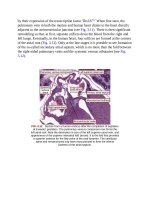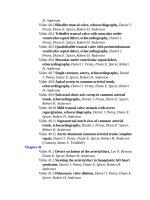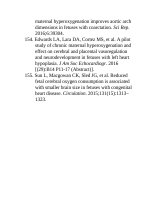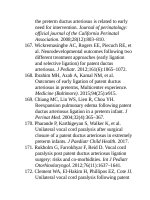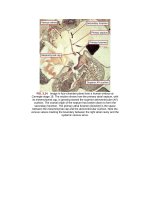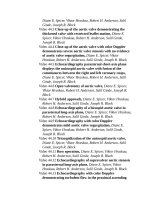Andersons pediatric cardiology 1190
Bạn đang xem bản rút gọn của tài liệu. Xem và tải ngay bản đầy đủ của tài liệu tại đây (142.93 KB, 3 trang )
echocardiographicassessmentisparalleltothatofaorticstenosis.Careful
interrogationoftheleftventricularoutflowtractintheparasternallongaxis
imagingplanewilldemonstratethemechanismofobstruction(Figs.44.25and
44.26;Videos44.16and44.17).Fullevaluationinapical,subcostal,and
suprasternalnotchviewswillalsoallowforoptimalspectralDopplerevaluation.
ColorDopplerisnecessarytolocalizetheflowturbulenceandtomakean
assessmentofaorticinsufficiency.Theseverityofthesubvalvarstenosisis
generallymadebysimilarcriteriaasvalvaraorticstenosis.
FIG.44.25 Fibromuscularsubaorticstenosis(arrows).Notethedistance
ofthefibromuscularridgefromtheleafletsofthevalve.Thereisextension
oftheshelfontotheaorticleafletofthemitralleaflet.ThecolorDoppler
traceshowsthattheturbulencestartsatthelevelofthesubaortic
obstruction.AO,Aorta;LA,leftatrium;LV,leftventricle.
FIG.44.26 Transesophagealechocardiogramfromapatientwith
subaorticstenosisproducedbyaccessoryleaflettissuederivedfromthe
mitralvalve(arrow).AO,Aorta;LA,leftatrium;LV,leftventricle;RV,right
ventricle.
Evaluationoftheaorticvalveanditsmotionshouldalsobeevaluatedinthe
parasternallongandshortaxisimagingplane.Theaorticvalveleafletsmaybe
notedtoflutterduetotheturbulencefromthesubaorticmembrane.Therehas
alsobeenincreasinguseofthree-dimensionalechocardiographytodemonstrate
thenatureofthelesionandtoaidinsurgicalmanagement(Fig.44.27).Finally,
echocardiogramprovidesimportantquantificationofleftventricularfunction
andhypertrophy.
FIG.44.27 Three-dimensionalechocardiogramshowingfibromuscular
subaorticstenosis(arrow),asseenfrombelowtheleftventricularoutflow
tract.Notethatincomparisontothecross-sectionalcounterpart(shownin
Fig.44.25),thethree-dimensionalreconstructionrevealsthefullextentof
theobstruction.LV,Leftventricle;MV,mitralvalve;RV,rightventricle.
CardiacCatheterization
Leftheartcatheterizationisnottypicallyusedfordiagnosisofsubaorticstenosis,
unlessthereisadiscrepancybetweennoninvasiveimagingfindingsandclinical
symptoms,ortobetterclarifythelevelofobstructioninpatientswithmultiple
outflowtractlesions.Agradientisobtainedacrosstheleftventricularoutflow
tractbydirectpull-backpressuremeasurementsusinganend-holdor
micromanometer-tippedcatheter.
Management
Interventiontoaddresssubaorticstenosisisindicatedinthesettingofleft
ventricularsystolicdysfunctionand/orassociatedsymptomssuchassyncope,
angina,anddiminishedexercisetolerance.Timingofinterventionin
asymptomaticpatientswithnormalcardiacfunctionislessclear.
Duetotheprogressivenatureofthedisorderandtheriskfordevelopmentof
aorticregurgitation,surgeryisusuallyadvisedatgradientslowerthanthoseused
todetermineinterventionforvalvaraorticstenosis.Surgeryshouldbe
consideredinasymptomaticpatientswithdiscretesubaorticmembranewhenthe
peakDopplergradientacrosstheleftventricularoutflowtractis50mmHgor
greaterormeangradientis30mmHgorgreater.179Theriskfordeveloping
moderatetosevereaorticregurgitationissignificantlygreaterwhenthepeak
gradientexceeds50mmHg.180–182Surgeryisalsoadvocatedwithlower
gradientsifthereisevidenceofprogressiveaorticvalveregurgitationduring
serialfollow-upimaging.Patientswithapeakgradientlessthan30mmHgand
nosignificantleftventriclehypertrophyarefollowedcloselyforprogression,
especiallyinthefirstseveralyearsoflife.
Inasymptomaticpatientswithtunnel-likeleftventricularoutflowtract
obstruction,surgeryshouldbeconsideredwhenthegradientis60mmHgor
greater.Inthesettingofhypertrophicobstructivecardiomyopathy,indicationfor
operationisdrivenbytheprogressionofsymptomsdespitethemaximum
medicaltherapy.
Althoughtranscatheterballoondilationhasbeenreportedfordiscrete
subaorticstenosis,183interventionisprimarilysurgical.Thesurgicalapproach
fordiscretesubaorticstenosisvariesdependingonsizeandfunctionoftheaortic
valveatthetimeofintervention(Fig.44.28).
